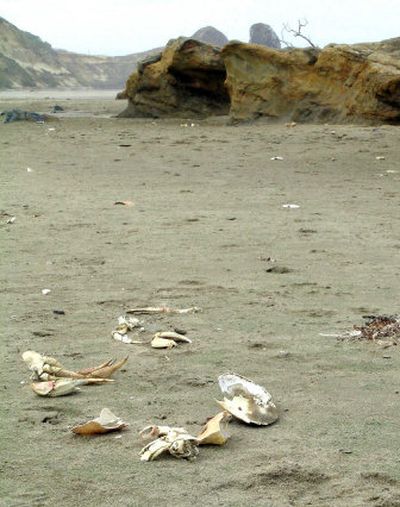Global warming cited as reason for Oregon ‘dead zone’

GRANTS PASS, Ore. – Bottom fish and crabs washing up on Oregon beaches are being killed by a recurring “dead zone” of low-oxygen water that appears to be triggered by global warming, scientists say.
The area is larger and more intense than in past years, and there are signs it is spreading north to Washington’s Olympic Peninsula.
Scientists studying a 70-mile-long zone of oxygen-depleted water along the Continental Shelf between Florence and Lincoln City have concluded it is being caused by explosive blooms of tiny plants known as phytoplankton, which die and sink to the bottom.
The phytoplankton are eaten by bacteria, which use up the oxygen in the water. The recurring phytoplankton blooms are triggered by north winds generating a rollover of the water column in a process known as upwelling.
“We are seeing wild swings from year to year in the timing and duration of the winds that are favorable for upwelling,” Jane Lubchenco, professor of marine ecology at Oregon State and a member of the Pew Oceans Commission, said from Corvallis. “This increased variability in the winds is consistent with what we would expect under climate change.”
Scientists first noticed a dead zone off Newport in 2002. That one was traced back to a rare influx of cold water rich in nutrients and low in oxygen that had migrated from the Arctic, said Jack Barth, professor of oceanography at Oregon State and, with Lubchenco, a principal investigator for the Partnership for Interdisciplinary Studies of Coastal Oceans.
Each year since 2002, dead zones have returned in the summer. But these have been caused by intense bursts of upwelling followed by calm periods. During the calm periods, when the water contains fewer nutrients, phytoplankton die for lack of food and fall to the ocean floor Barth said.
This year, the upwelling started strongly in April, stalled in May and picked up again in late June. Following the upwellings, scientists found the oxygen levels lower.
The off-and-on action of the upwelling builds up a thick layer of organic material that robs the water of oxygen as it rots. When a new upwelling occurs, it draws the deadly water toward shore, killing fish and crabs that cannot get out of its way, Barth said.
“We know it’s not pollution. It’s not a toxic algal bloom. The simple fact is there’s not enough oxygen,” said Francis Chan, a research professor of zoology at Oregon State who has been measuring the oxygen levels.
Oxygen levels are generally lower in deeper water, where fish evolve to deal with it, said Lubchenco. What is unusual about this condition is that it is moving into relatively shallow water, about 50 feet deep, and moving toward shore, where the richest marine ecosystems are.
Monitoring of oxygen levels in the ocean has documented the dead zone in varying intensities along 70 miles of coast from Florence to Lincoln City, but the ribbon of dead phytoplankton on the ocean bottom that creates it could extend to Washington’s Olympic Peninsula, where dead crabs and fish have been showing up, Barth said.
“If we continue like we are now, we could see some ecological shifts,” Barth said. “It all depends on what happens with the warming and the greenhouse gases.”
Dead zones in other places around the country, such as Hood Canal in Washington and the Mississippi River Delta off Louisiana, are caused by agricultural runoff fueling blooms of algae that rot and deplete the oxygen, said Lubchenco. But dead zones like the one off Oregon also occur off Namibia and South Africa in the Atlantic and off Peru in the Pacific.
“We’re not really sure what is down the road. If it’s just for a short period of time, it will not be as devastating as if it starts lasting a significant fraction of summer,” she said.
Crab fishermen in Oregon and Washington are finding dead crabs in their pots, and deeper water fish, such as ling cod, wolf eels and rockfish, are showing up in Oregon tide pools, apparently chased to shore by the dead zone advancing across the Continental Shelf, said Lubchenco.
In Washington, dead fish and crabs are also being spotted on the beach along the Olympic Coast National Marine Sanctuary and the Quinault Indian Reservation, Liam Antrim, resource protection specialist for the marine reserve, said from Port Angeles, Wash.
“Last year we did some routine monitoring along six transects every other week. We never documented low oxygen conditions low enough to kill things,” Antrim said. “This year we have.”